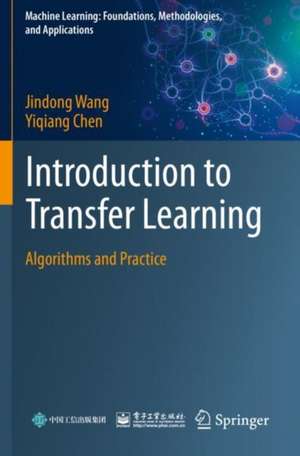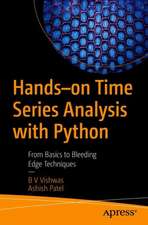Introduction to Transfer Learning: Algorithms and Practice: Machine Learning: Foundations, Methodologies, and Applications
Autor Jindong Wang, Yiqiang Chenen Limba Engleză Paperback – 20 iun 2024
This book offers a comprehensive tutorial on an overview of transfer learning, introducing new researchers in this area to both classic and more recent algorithms. Most importantly, it takes a “student’s” perspective to introduce all the concepts, theories, algorithms, and applications, allowing readers to quickly and easily enter this area. Accompanying the book, detailed code implementations are provided to better illustrate the core ideas of several important algorithms, presenting good examples for practice.
| Toate formatele și edițiile | Preț | Express |
|---|---|---|
| Paperback (1) | 298.43 lei 38-44 zile | |
| Springer Nature Singapore – 20 iun 2024 | 298.43 lei 38-44 zile | |
| Hardback (1) | 406.32 lei 22-36 zile | +29.10 lei 5-11 zile |
| Springer Nature Singapore – 31 mar 2023 | 406.32 lei 22-36 zile | +29.10 lei 5-11 zile |
Preț: 298.43 lei
Preț vechi: 373.04 lei
-20% Nou
Puncte Express: 448
Preț estimativ în valută:
57.12€ • 62.07$ • 48.01£
57.12€ • 62.07$ • 48.01£
Carte tipărită la comandă
Livrare economică 16-22 aprilie
Preluare comenzi: 021 569.72.76
Specificații
ISBN-13: 9789811975868
ISBN-10: 9811975868
Ilustrații: XXI, 329 p. 1 illus. in color.
Dimensiuni: 155 x 235 mm
Ediția:1st ed. 2023
Editura: Springer Nature Singapore
Colecția Springer
Seria Machine Learning: Foundations, Methodologies, and Applications
Locul publicării:Singapore, Singapore
ISBN-10: 9811975868
Ilustrații: XXI, 329 p. 1 illus. in color.
Dimensiuni: 155 x 235 mm
Ediția:1st ed. 2023
Editura: Springer Nature Singapore
Colecția Springer
Seria Machine Learning: Foundations, Methodologies, and Applications
Locul publicării:Singapore, Singapore
Cuprins
Part I. Foundations of Transfer Learning.- Chapter 1. Introduction.- Chapter 2. From Machine Learning to Transfer Learning.- Chapter 3. Overview of Transfer Learning Algorithms.- Chapter 4. Instance Weighting Methods.- Chapter 5. Statistical Feature Transformation Methods.- Chapter 6. Geometrical Feature Transformation Methods.- Chapter 7. Theory, Evaluation, and Model Selection.- Part II. Modern Transfer Leaning.- Chapter 8. Pre-training and Fine-tuning.- Chapter 9. Deep Transfer Learning.- Chapter 10. Adversarial Transfer Learning.- Chapter 11. Generalization in Transfer Learning.- Chapter 12. Safe & Robust Transfer Learning.- Chapter 13. Transfer Learning in Complex Environments.- Chapter 14. Low-resource Learning.- Part III. Applications.- Chapter 15. Transfer Learning for Computer Vision.- Chapter 16. Transfer Learning for Natural language Processing.- Chapter 17. Transfer Learning for Speech Recognition.- Chapter 18. Transfer Learning for Activity Recognition.- Chapter 19. Federated Learning for Personalized Healthcare.- Chapter 20. Concluding Remarks.
Notă biografică
Jindong Wang is currently a senior researcher at Microsoft Research Asia. Before that, he obtained his PhD from the Institute of Computing Technology, Chinese Academy of Sciences, in 2019. His main research interests are in transfer learning, domain adaptation, domain generalization, and their applications in ubiquitous computing systems. He has co-published a Chinese-language textbook, Introduction to Transfer Learning, and numerous papers in leading journals and conferences, such as the IEEE TKDE, TNNLS, ACM TIST, NeurIPS, CVPR, IJCAI, UbiComp, and ACMMM. He was awarded the best application paper at the IJCAI'19 federated learning workshop and best paper at ICCSE'18. He has served as the publicity chair of IJCAI'19 and the transfer learning session chair of ICDM'19.
Yiqiang Chen is currently a professor at the Institute of Computing Technology, Chinese Academy of Sciences. His main research interests are in artificial intelligence and pervasive computing. He has published more than 180 papers in leading journals and conferences such as the IEEE TKDE, AAAI, and IJCAI. He has served as the general PC chair of the IEEE UIC 2019, PCC 2017, and CWCC 2019. He is a founding committee member of the IEEE wearable and intelligent interaction committee (IWCD) and an associate editor for IEEE TETCI and IJMLC. He has won several best paper awards, including best application paper at IJCAI-FL'19, IJIT 15th anniversary best paper award, and ICCSE'18 best paper award.
Yiqiang Chen is currently a professor at the Institute of Computing Technology, Chinese Academy of Sciences. His main research interests are in artificial intelligence and pervasive computing. He has published more than 180 papers in leading journals and conferences such as the IEEE TKDE, AAAI, and IJCAI. He has served as the general PC chair of the IEEE UIC 2019, PCC 2017, and CWCC 2019. He is a founding committee member of the IEEE wearable and intelligent interaction committee (IWCD) and an associate editor for IEEE TETCI and IJMLC. He has won several best paper awards, including best application paper at IJCAI-FL'19, IJIT 15th anniversary best paper award, and ICCSE'18 best paper award.
Textul de pe ultima copertă
Transfer learning is one of the most important technologies in the era of artificial intelligence and deep learning. It seeks to leverage existing knowledge by transferring it to another, new domain. Over the years, a number of relevant topics have attracted the interest of the research and application community: transfer learning, pre-training and fine-tuning, domain adaptation, domain generalization, and meta-learning.
This book offers a comprehensive tutorial on an overview of transfer learning, introducing new researchers in this area to both classic and more recent algorithms. Most importantly, it takes a “student’s” perspective to introduce all the concepts, theories, algorithms, and applications, allowing readers to quickly and easily enter this area. Accompanying the book, detailed code implementations are provided to better illustrate the core ideas of several important algorithms, presenting good examples for practice.
This book offers a comprehensive tutorial on an overview of transfer learning, introducing new researchers in this area to both classic and more recent algorithms. Most importantly, it takes a “student’s” perspective to introduce all the concepts, theories, algorithms, and applications, allowing readers to quickly and easily enter this area. Accompanying the book, detailed code implementations are provided to better illustrate the core ideas of several important algorithms, presenting good examples for practice.
Caracteristici
Fast and painless icebreaker for your journey into transfer learning Clear summaries of both classic and more recent algorithms Complementary source codes for good practice examples





































